Make a Mason Jar Bee Feeder
You may be surprised to learn how easy it is to make your own mason jar bee feeder. It is the easiest and most basic method for feeding honey bees. Jar feeding is not best in all circumstances but it is a fast reliable method to provide food for new or small colonies.
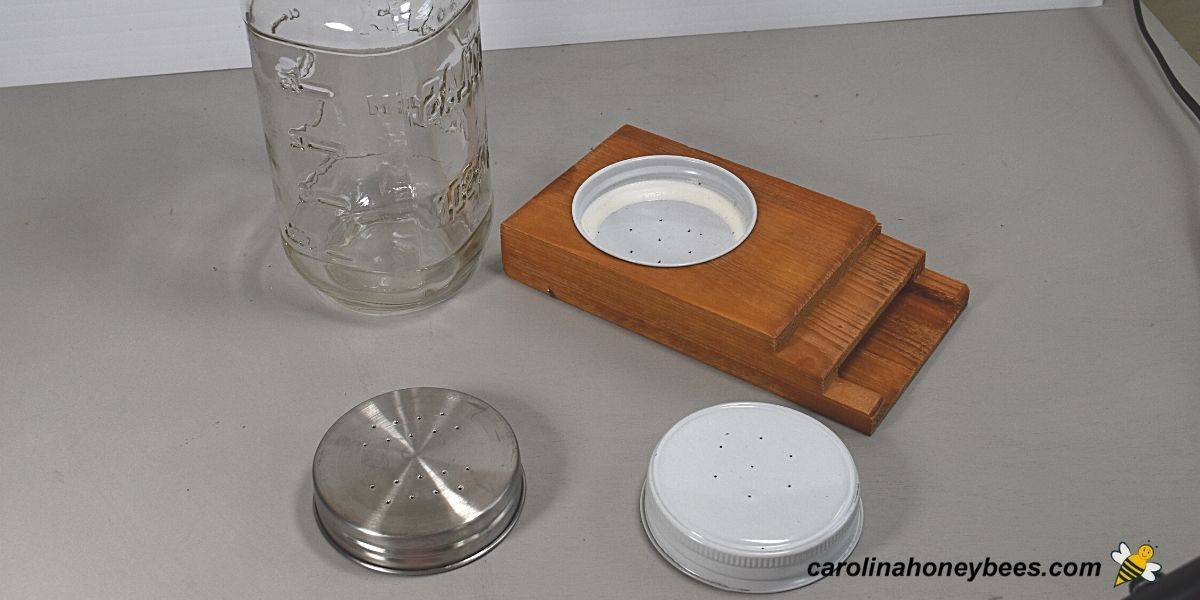
Most beekeepers find it necessary to provide extra nourishment for colonies during some part of the season. However, providing sugar water for bees should not be a year round activity.
DIY Bee Feeders Using a Jar
Healthy colonies in areas that provide ample food for foraging bees should be able to take care of themselves-in most situations. If you find yourself constantly feeding during times of good weather and forage – you have another problem.
Perhaps your hives are victims of being robbed. Another possibility, especially for newer beekeepers, you may have too many beehives in one location.
Ultimately, there will always be some new hives or small swarms that can benefit from some extra nutrition.
Choosing the Jar
The construction of this type of jar bee feeder is as easy as can be. You only need a glass (usually a quart) and a lid that fits-water tight. Plastic works too of course – but glass is a bit more durable.
Clear glass containers are popular because you can see through them to know when they are empty. I like to reuse old spaghetti jars and lids – just make sure they are clean.
This project is hard to mess up. However, using it in the best way can offer some challenges. Failure to pay attention to proper use may put your bees at risk of attack by other colonies.
Challenges of Homemade Feeders
Making your own homemade jar bee feeders is a easy project and a great way to save money. It’s nice to be able to use things you already have on hand. Beekeeping costs are expensive enough as it is.
There are 2 major things to be concerned about when designing or using a feeder for bees.
1. Stop Leaks
The feeder must not leak. This applies to any type that you may use in your hive. Leaking sugar water results in a struggle to keep ants out of the beehive.
Leaky feeders can also encourage honey bee robbing behavior. Robbing is sometimes difficult to stop once it starts and small colonies may be wiped out.
2. Minimize Drowning
Your feeder should not allow many bees to drown. Many feeder types result in a small number of dead bees. Bees can drown really easy if given access to a pool of sweet sugar water.
One of the most simple and easy to use feeders is with the use of a mason jar. Because the bees can not get inside the jar – drowning is not usually a problem.
This feeder is effective and very popular. However, it is not always used in the best way. Even though you will see many images of hanging jars on the hive entrance. If done wrong it can cause serious problems for the colony.
This post may contain affiliate links. As an Amazon Associate, I earn from qualifying purchases. Please read my disclosure.
How a Jar Feeder Works
When a the glass jar is filled with liquid, a small amount of air remains inside near the top. Now, add a tight fitting lid (with several small holes) and invert the jar. A small amount of liquid will leak out of small holes in the lid.
The larger the jar and the more empty air space you have inside – the more water that flows out before the vacuum.
Once a vacuum is formed and the remainder of the liquid stays in the jar. That is unless you shake it or a bee is sucking the food out of one of those holes in the lid.
This method works really well and having several holes in the lid allows more than 1 bee to drink at a time. However, you will need to do a bit of maintenance.
Over time, metal lids can get rusty, clogged and rather gnarly. Just replace them. Or if you want to try something new – these plastic Bee Bar lids have received a lot of rave reviews.
Problems With Hive Front Feeders
In my opinion, the worst way to use a mason jar bee feeder, is the most advertised one. We have all seen the images that feature a glass feeder inserted into the entrance of the hive.
Hanging a jar feeder on the front of the hive is not a good idea. Yes, it is convenient and it is easy for the beekeeper to see how much sugar water is left.
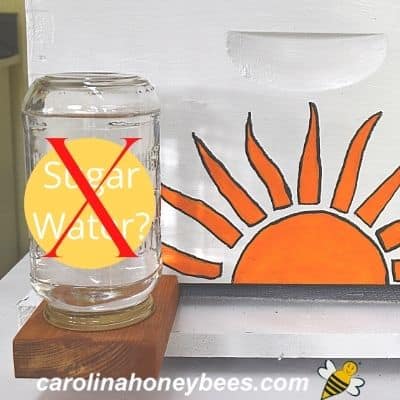
However, in so many situations – those front feeders cause problems for the bees. Robber bees are attracted to the smell of sugar water. Having that “advertisement” of sweet goodies on your hives front porch is just not the best situation.
In a bee yard with multiple hives, a leaky feeder or split syrup can cause a robbing frenzy quickly. This could result in the loss of your hive. If you do use your feeder on the front – watch closely for any sign of robbing.
There is a better way to make use of that front feeder that came with your beekeeping kit. Instead of syrup, use a jar feeder to offer water to your bees.
This is especially important in an area that is lacking in good water sources for bees. Providing water will not cause any problems with other hives invading your weak colonies.
And, it might just help keep your bees from visiting your neighbor’s swimming pool? And, that is a good way to be a good bee neighbor.
Jar Feeder and Boardman Feeder
The Boardman Feeder (jar and lid with wooden base), also called an entrance feeder, is designed to sit on the front of the hive. This unit consists of a base (usually wood) and the jar and lid.
In essence it is simply a mason jar feeder with a wooden base. Both work the same way. There are many different ways to install them. Each beekeeper has his/her own idea of what is best.
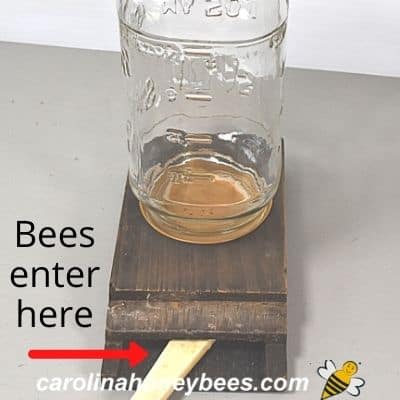
The front portion slides into the hive entrance. An entry passage in the bottom allows bees to access the holes in the lid.
Use the boardman feeder for water – simply fill your clean jar with water. Invert the jar allowing some water to flow out of the holes in the lid. Place the jar in the feeder and slide it into the hive entrance.
Using Homemade Bee Feeders inside the Hive
Feeding bees inside the hive is always the most economical option. You are putting food where the bees can access it 24/7 regardless of wind or rain that prevents bees flying..
The honey bees will benefit from all of the sugar water in the feeder. Also, you will not be feeding every wasp in the neighborhood.
Just be sure to reduce the hive entrance to a smaller opening when feeding bees in your apiary. Weak hives may not be able to defend themselves against intruders wanting a snack.
Each method will require you having an extra empty hive body or “deep” to enclose the jars. The outer lid goes on top to seal and protect the hive.
Here are some common ways to use your mason jar bee feeders:
- place feed jars directly on the top bars
- use boardman feeders on top of the inner cover
- use a platform to hold 1 or more jars on top of the inner cover
Jars on the Top Bars
This method involves sitting the jar directly on the top bars of the frames. Commonly used when a colony is very weak and the weather is cold.
I have used it when installing a new package of bees and the temperatures are going to be freezing the first few nights.
The disadvantages include the fact that jars do sometimes leak a bit due to temperature fluctuations. We do not want the sugar water to leak down on the bees – especially the queen.

If you use this method for a tiny colony in cold weather, sit the jars within reach of the edge of the cluster but not directly over a queen cage or bee brood.
Also, as some of the holes in the lid will be blocked by the frames – not every drinking hole is accessible. That’s is why putting several small holes is a good idea.
Boardman Feeder Inside the Hive
Another popular technique for feeding is – using a boardman feeder (jar and base) inside the hive. In this situation, the jar is prepared – placed in the feeder and the entire thing is put on top of the inner cover – near the middle opening. A deep brood box around enables the hive to be closed.
The feeder holes of the lid are accessible because of the wooden base. Even if the jar leaks just a bit, it is less likely to drip down on the bees.
You know…. while you are at it – if those bees really need fed – why are you using only 1 quart jar? How about 2 or 3?
2 Jar Feeder or Slats Method
If you do not have the boardman feeder bases, a common practice is to use 2 small sticks of wood to elevate the jars up off the surface. This can be done directly on the frames or above the inner cover.
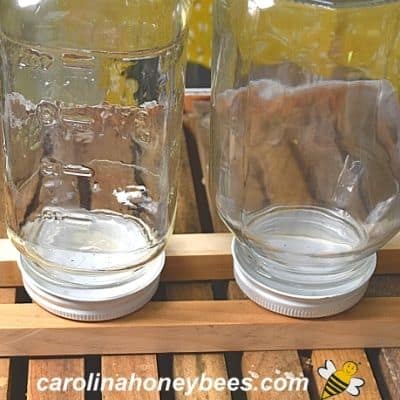
An advantage to having feeders above the inner cover is that it is less disruptive to the colony when you need to refill them.
Some inventive beekeepers build special 2 jar feeder holders (or 4). These platforms can be nailed or glued together making it very easy to move several jars of food at a time.
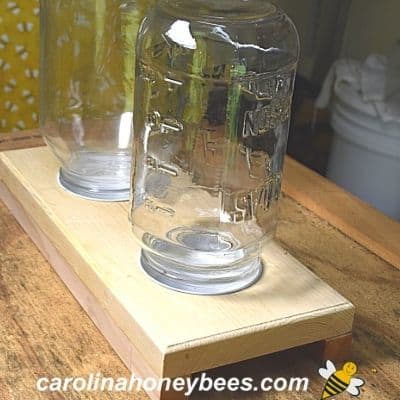
More Ideas
The importance of feeding bees in need can not be overlooked. We feed other types of livestock when they are in need – honey bees are no different.
In some cases, a beekeeper might use something larger such as a DIY bucket feeder. They are not as efficient but can be useful at times – allowing the beekeeper to leave a larger amount of food in one visit.
A Final Word
There are many ways to feed bees and none of them are without advantages and disadvantages. Each beekeeper must consider the needs of the colony at a given time.
Making your own mason jar bee feeder is a quick and easy method of feeding during warm weather. Having several different feeding methods is good because each one works a bit differently.
For the beginner starting out with a couple of hives, this method works well.
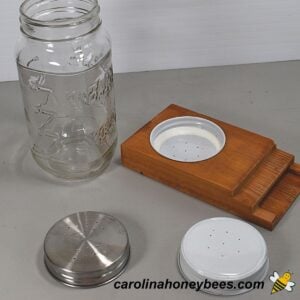
DIY Jar Bee Feeder Step by Step
This post may contain affiliate links. As an Amazon Associate, I earn from qualifying purchases.
Read my Disclosure.Tools
- Hammer
- Small Nail
- small block of wood (optional)
Supplies
- 1 piece Quart Jar
- 1 piece lid for quart jar
Instructions
- Begin with a clean glass jar. Mason ( is a type or brand) you just need a clean glass jar – quart size is good. You also need a lid. It can be a 1 piece lid or the 2 piece canning lids but it should be the standard regular size. Yes, you can use plastic but glass is most common.

- Punch small holes in the lid. Use a hammer and a small finishing nail to punch 5 – 8 very small holes near the center of the lid. If you make the holes too big, the sugar water feed will pour out too quickly. This isn't rocket science – just space them out to give bees room to drink.

- If needed, a small block of wood can support the metal surface of a 1 piece lid as you make the holes.The lid you are using may be sturdy enough to avoid needing a support – it really depends on the thickness of the lid in question

- Fill clean jar with sugar syrup. A 1:1 mixture is the most common ratio used for feeding weak colonies.Add the lid and tighten it securely – then rinse the whole feeder to remove any sticky sugar water drips.Invert the jar – you will see some drips as the liquid creates a vacuum. If drips continue more than a few seconds – your lid is not creating a good seal.Turn right side up and your jar feeder is ready to use. Understand that when you flip it back over in the bee yard it will drip again. Make sure it is full to the top.






